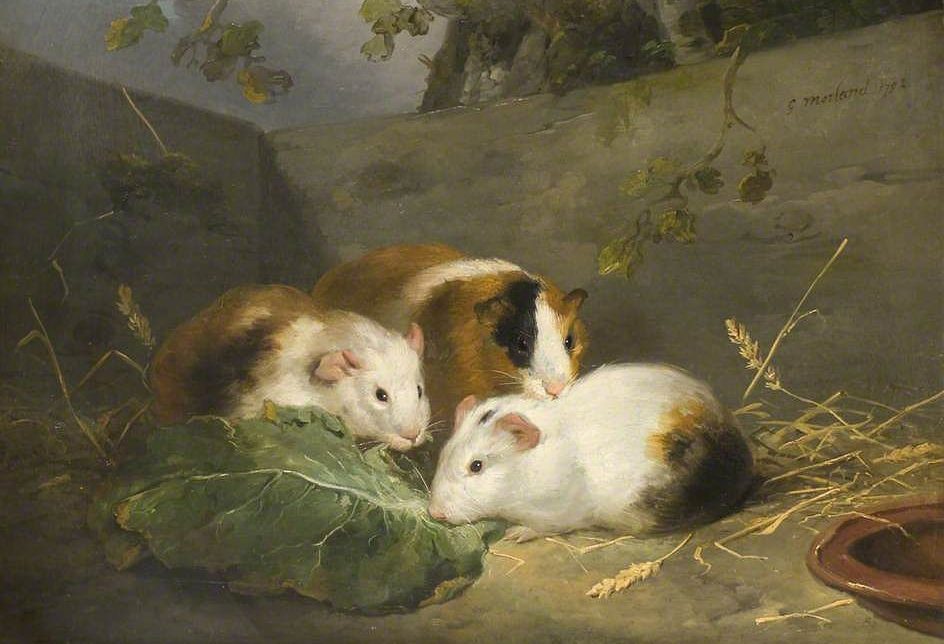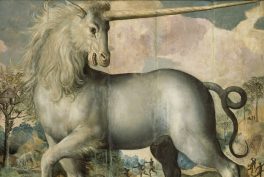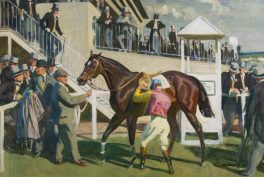Summary
What are the hidden secrets of pets in art? Here’s a brief look at the meanings and symbols behind depictions of popular domestic animals in art.
- Dogs: guidance, protection, loyalty, faithfulness, fidelity, alertness, and love.
- Cats: femininity, fertility, promiscuity, lust, deception, betrayal, laziness, dark forces, comfort, and homeliness.
- Guinea pigs: fruitfulness.
- Rabbits: fertility, lust, rebirth/resurrection, and sex.
Dogs
Let’s start with the man’s best friend – dogs. They’re quite frequently portrayed in art and for good reason. Dogs in art can be domesticated companions, elegant lapdogs showing their owners’ status, protectors of the family, or helpful hunters. The history of their depictions is almost as old as the history of the dog-human friendship itself, with the oldest images being up to 8000 or 9000 years old! Just as these loyal pets haven’t left our side to this day, dogs can be found throughout all artistic eras and genres.
They’re also usually symbolic. You won’t be surprised to learn that dogs in paintings can carry meanings of guidance, protection, loyalty, faithfulness, fidelity, alertness, and love. This obviously depends on the context, age, and the depiction’s provenance.
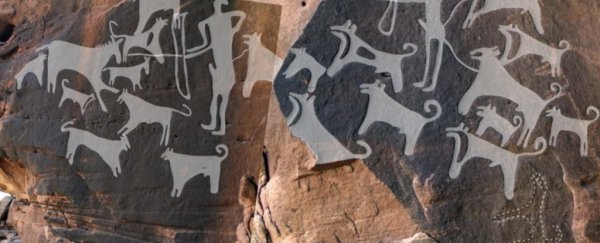
Pets in Art: Prehistoric Rock Art Panel, 7000–6000 BCE, Shuwaymis and Jubbah archeological sites, Saudi Arabia. Science Alert.
Love, Faithfulness, and Fidelity
The symbol of dogs in art is visible in one of the most famous paintings ever – the Portrait of Giovanni Arnolfini and his Wife by Jan van Eyck, also known just as The Arnolfini Portrait. While the whole painting is full of hidden secrets and symbols, our interest here lies in the tiny pup standing between the couple. This little Griffon Terrier represents the couple’s fidelity and loyalty to one another. Since he is not a hunting dog, he also indicates wealth and status.
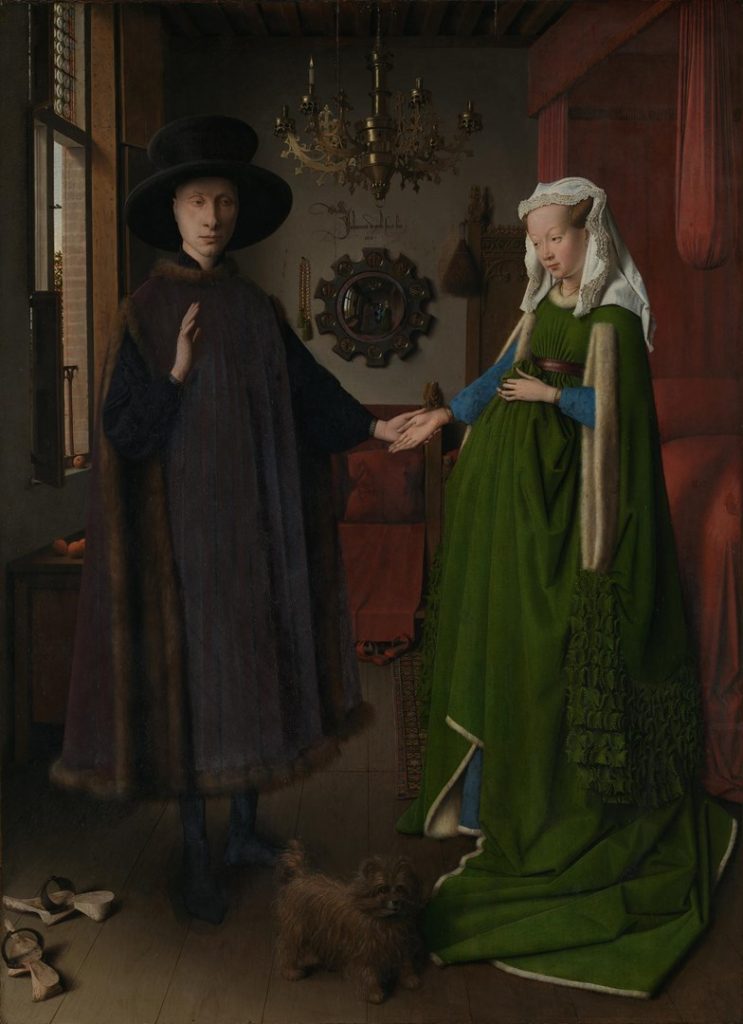
Pets in Art: Jan van Eyck, Portrait of Giovanni Arnolfini and his Wife, 1434, National Gallery, London, UK. Museum’s website.
A similar meaning can be found in Lavinia Fontana‘s Portrait of a Noblewoman. As it is most likely a marriage portrait, the tiny dog underlines both her wealthy status, as well as the unidentified noblewoman’s loyalty and fidelity to her bestowed.
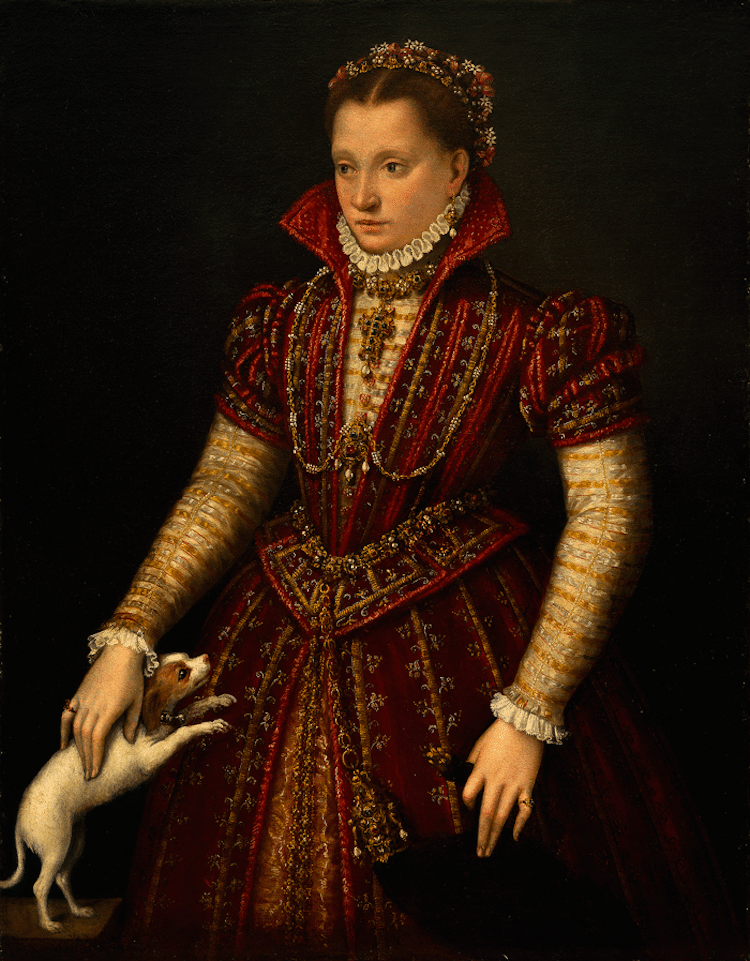
Pets in Art: Lavinia Fontana, Portrait of a Noblewoman, 1580, National Museum of Women in the Arts, Washington DC, USA. Museum’s website.
In Veronese’s Happy Union panel from the Allegories of Love series, the dog is just one of the symbols of a faithful, happy marriage, together with Venus, Cupid, the gold chain (marriage), olive branch (peace) and a laurel wreath (virtue).
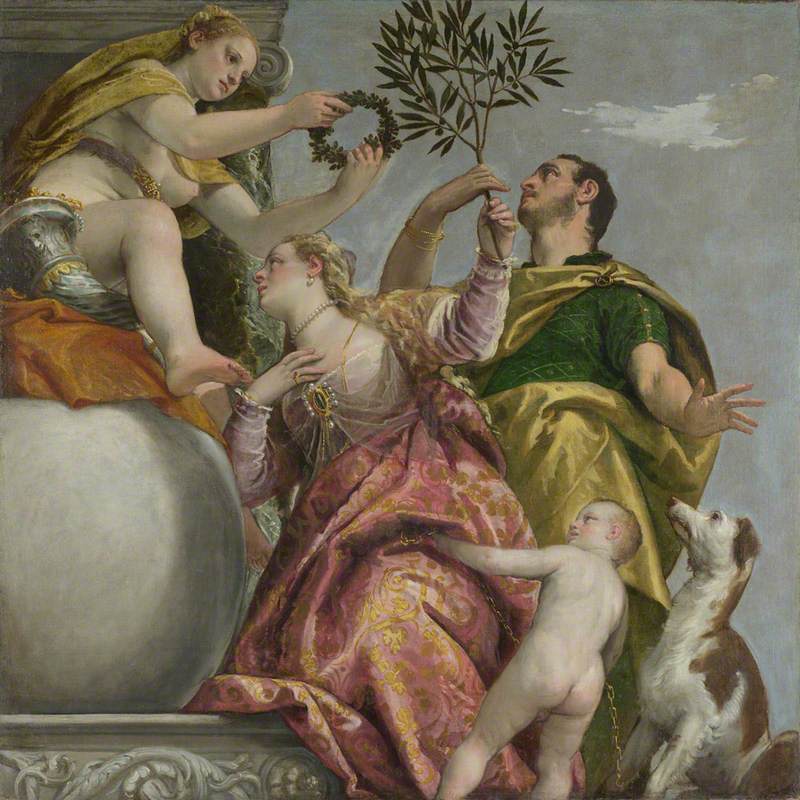
Pets in Art: Paolo Veronese, Happy Union (from Allegories of Love), 1575, National Gallery, London, UK. ArtUK.
Devotion and Loyalty
While devotion and loyalty can be romantic traits, they’re often associated on a more platonic, religious level. In The Washing of the Feet by Tintoretto, the dog in the middle of the scene signifies Jesus’s ultimate devotion to his disciples – and their devotion to Jesus.
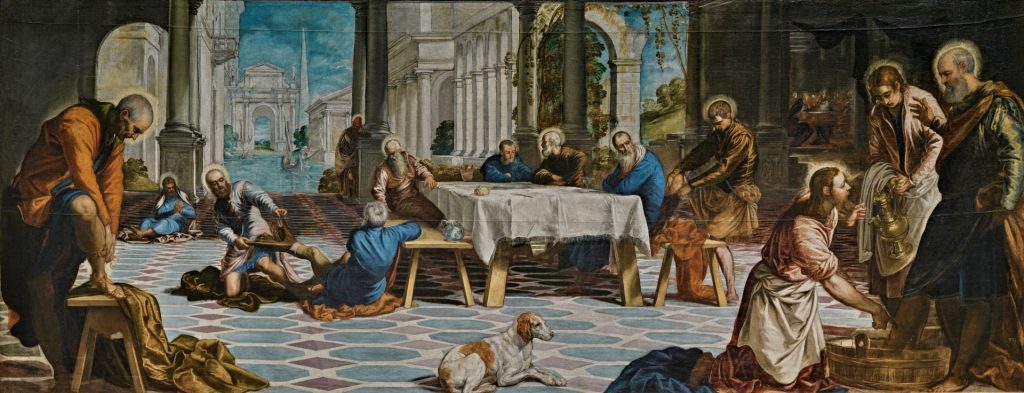
Pets in Art: Tintoretto, The Washing of the Feet, 1548-49, Museo Nacional del Prado, Madrid, Spain. Museum’s website.
Alertness, Protection, and Guidance
Dogs are kept not just as cuddle buddies, but also as a way to discourage potential intruders. Chinese Foo dogs, also known as Imperial Guardian Lions, were sculptures traditionally kept in front of the house in order to protect the building from harmful energy. Furthermore, they are known to bring prosperity and wealth. Fun fact: If you ever wondered why Pekingese dogs are so weird looking, it’s precisely because they were intentionally bred to resemble the mythical Foo-lion-dogs.
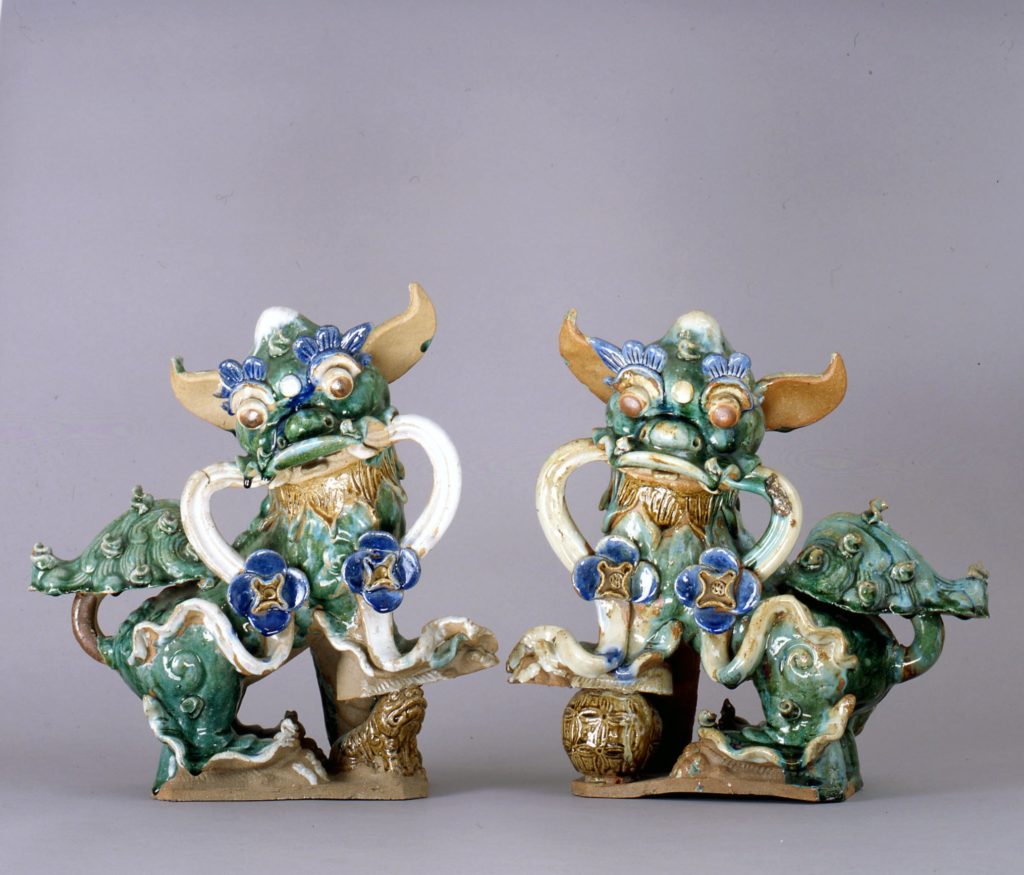
Pets in Art: Foo Dog Figurines, around 1890, Museum of Sonoma County, CA, USA. Museum’s website.
Here’s an ancient version of the well-known “Beware of the Dog” warning signs – the Cave Canem Roman mosaic from the House of The Tragic Poet in Pompeii. Cave Canem can be directly translated to “Beware of the dog” in Latin. The scary dog is most likely a Neapolitan mastiff, a guard dog used since the days of Ancient Rome.
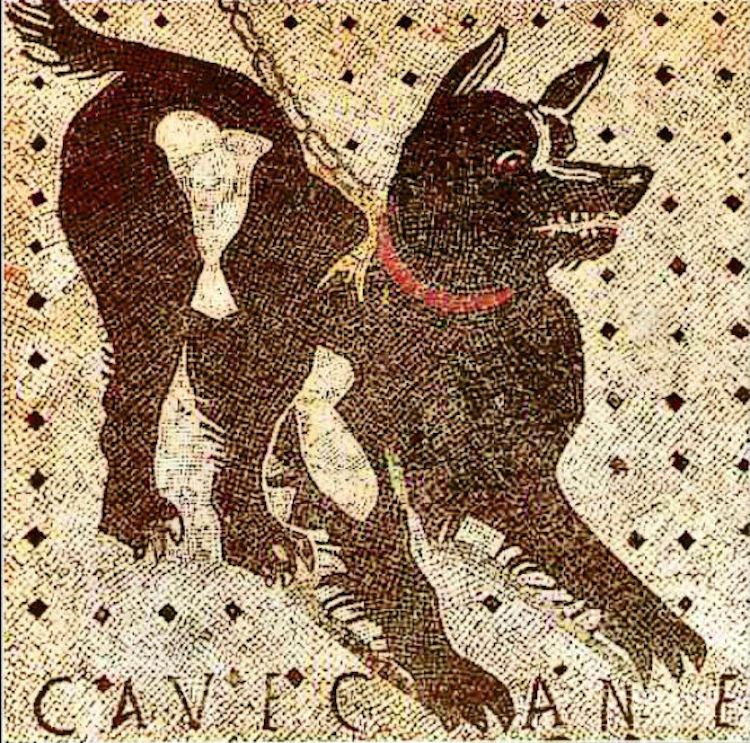
Pets in Art: Cave Canem Roman Mosaic, 2nd century BCE, House of the Tragic Poet, Pompeii, Italy. Yale University Library.
Cats
An affinity for cats and art often goes hand in hand. With the dozens of DailyArt Magazine cat articles, you’re probably already aware of the chokehold these graceful creatures have on artists. But what do they symbolize?
Cats are commonly used as symbols of femininity, fertility, promiscuity, lust, deception, betrayal, laziness, dark forces, comfort, and homeliness. Makes so much sense, doesn’t it? Cats are quite spectacular, but they’re definitely dealing with the devil every so often. We forgive them though, they’re so cute.
Feline Deities
The art world is full of feline deities and they are almost exclusively represented by female figures – a connotation that can be stretched to fertility and homeliness, but also darker traits such as lust or promiscuity. The earliest and best known female cat-goddess is Bastet, an ancient Egyptian deity whose name in Greek can be directly translated to “cat” (αἴλουρος). She was worshiped from the time of the Second Dynasty and her cult was mainly gathered in the Bubastis temple, where archeological excavations uncovered over 300,000 mummified cats.
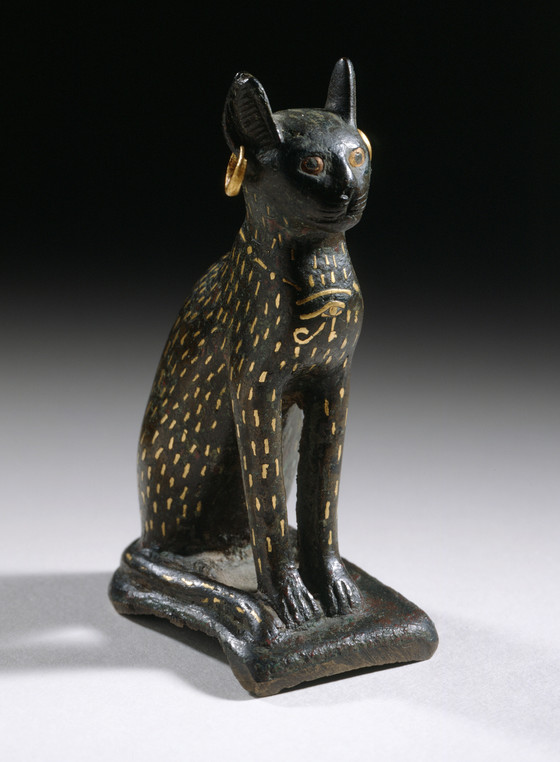
Pets in Art: Figurine of the Goddess Bastet as a Cat, Late Period, 712–332 BCE, Ancient Egypt, Los Angeles County Museum of Art, Los Angeles, CA, USA. Museum’s website.
Norse mythology associated the goddess Freyja with cats. She represented traits such as love, beauty, fertility, sex, war, and the power of influencing and seeing the future. She rode a chariot, pulled by – you guessed it – two giant cats.
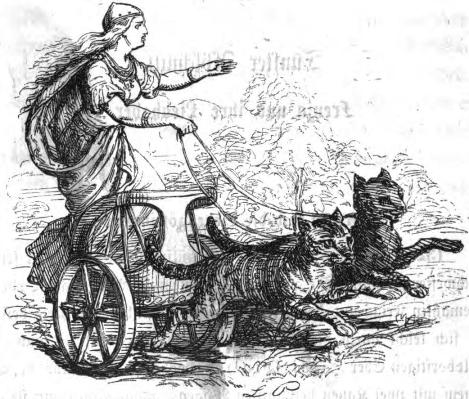
Pets in Art: Ludwig Pietsch, Goddess Freyja, 1865, illustration from Die Nordischen Gottersagen by Rudolf Friedrich Reusch. Archive.org.
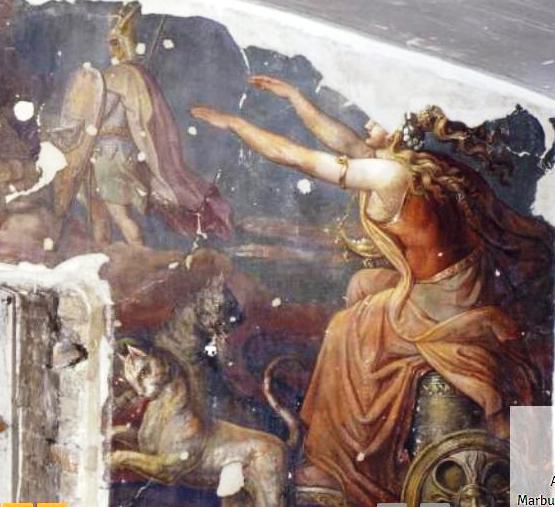
Pets in Art: Robert Muller, Fresco with Goddess Freyja, ca 1928, Neues Museum, Berlin, Germany. Germanic Mythology. Detail.
Madonna of the Cat
Beginning in the Middle Ages, cats were commonly associated with the Virgin Mary as a symbol of her grace and fertility. Furthermore, according to Italian folklore (source unconfirmed), a cat in Bethlehem gave birth on the same night that Mary gave birth to Jesus. Another legend states that when Jesus was born, the only thing that could calm the baby and stop him from crying was a purring tabby living in the manger. Cats are therefore often present in the Annunciation and Holy Family scenes.
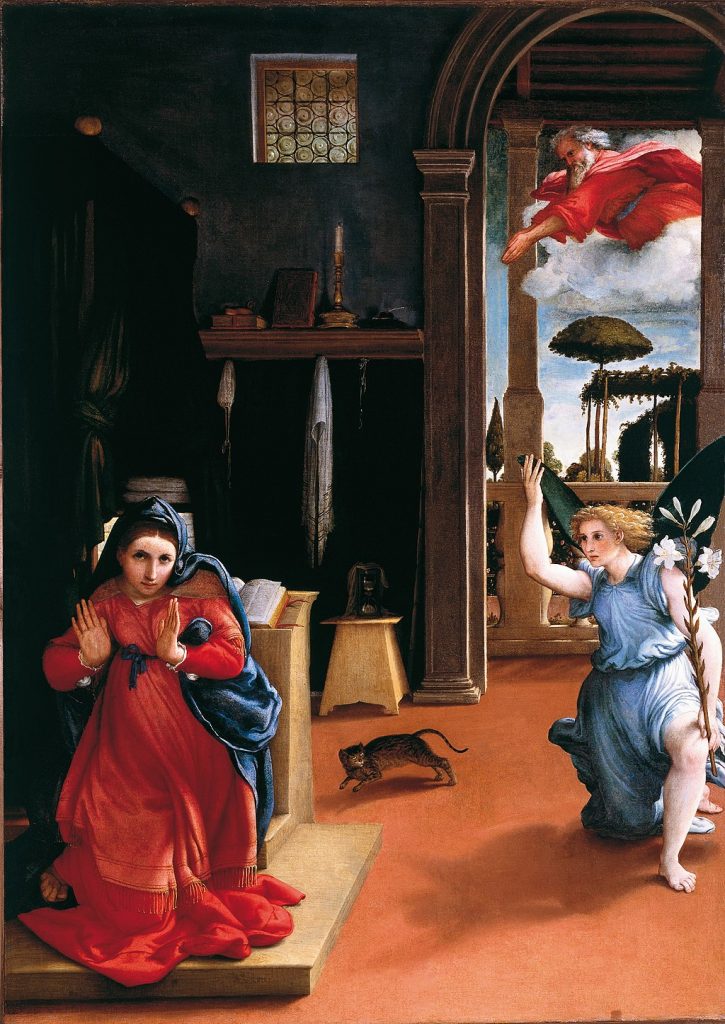
Pets in Art: Lorenzo Lotto, The Recanati Annunciation, ca 1530, Villa Colloredo Mels Museum, Recanati, Italy. Wikimedia Commons (public domain).
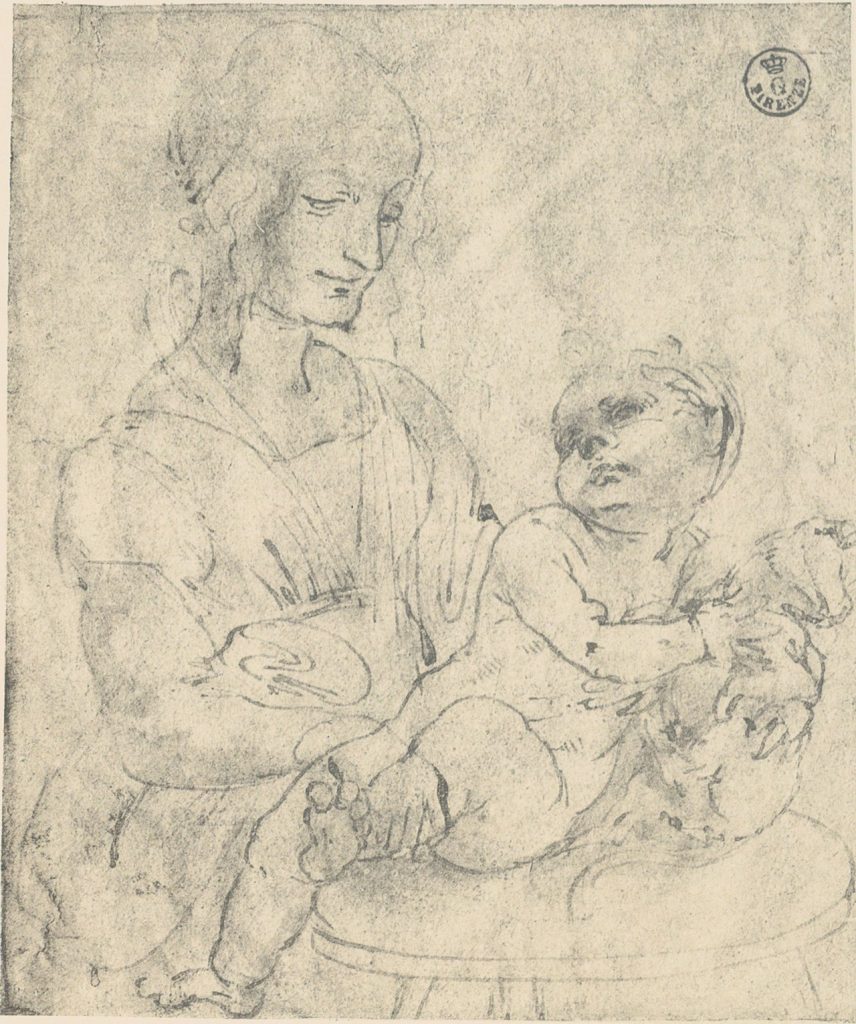
Pets in Art: Leonardo da Vinci, Madonna with the Child Caressing a Cat, ca. 1480, Galleria degli Uffizi, Florence, Italy. Wikimedia Commons (public domain).

Pets in Art: Rembrandt, Holy Family with a Curtain, 1646, Gemäldegalerie Alte Meister, Kassel, Germany. Wikimedia Commons (public domain).
The Traitor Cat
Cats purr sweetly and can calm down babies, but they are also known to be rather minacious. If you look closely at some of the Last Supper scenes, you might find a cat sitting near Judas’ feet. Here, the feline has negative association with deceit and treachery, signifying Judas’ future betrayal.
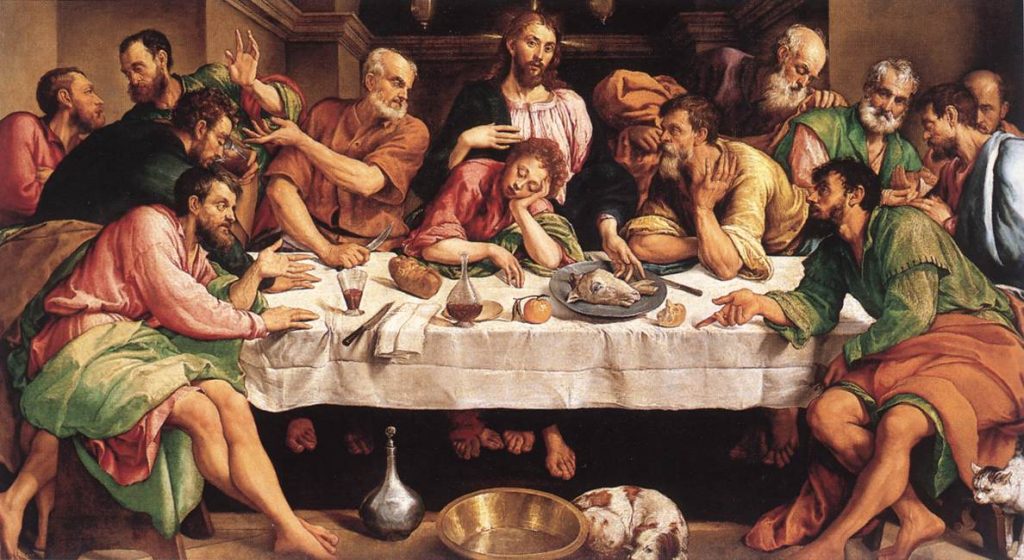
Pets in Art: Jacopo Bassano, The Last Supper, ca 1546, Galleria Borghese, Rome, Italy. Web Gallery of Art.
Guinea Pigs
My own personal fluff balls wouldn’t forgive me if I didn’t include guinea pigs in this article. So, they will come third – you’re welcome.
Guinea pigs are not only a cute sight for all sore eyes, but also a common addition in many paintings. You most likely won’t find them in European symbol dictionaries as they only appeared on the old continent in the 16th century. At that time they were brought from Peru following the European exploration of South America. They were still fondly portrayed with people, not only due to their undeniable charm, but also as a signal of belonging to the upper-class, given their exotic provenance. Long before reaching Europe, guinea pigs were domesticated in the Andes approximately 7000 years ago.
For now, the oldest European depiction of the guinea pig is a little known painting of three Elizabethan-era children, recently uncovered in the National Portrait Gallery in London.
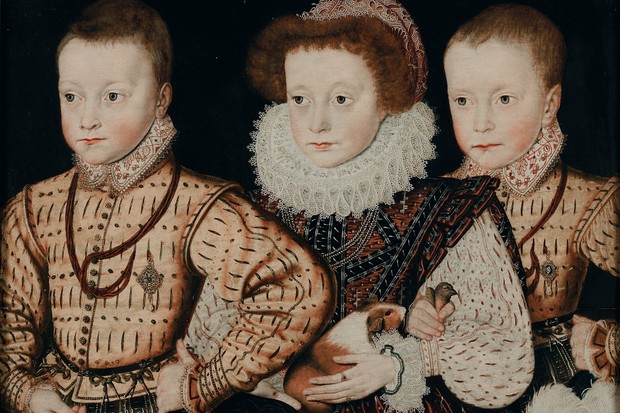
Pets in Art: Three Unknown Elizabethan Children (working title), ca 1580, Anglo-Netherlandish, National Portrait Gallery, London, UK. Museum’s website.
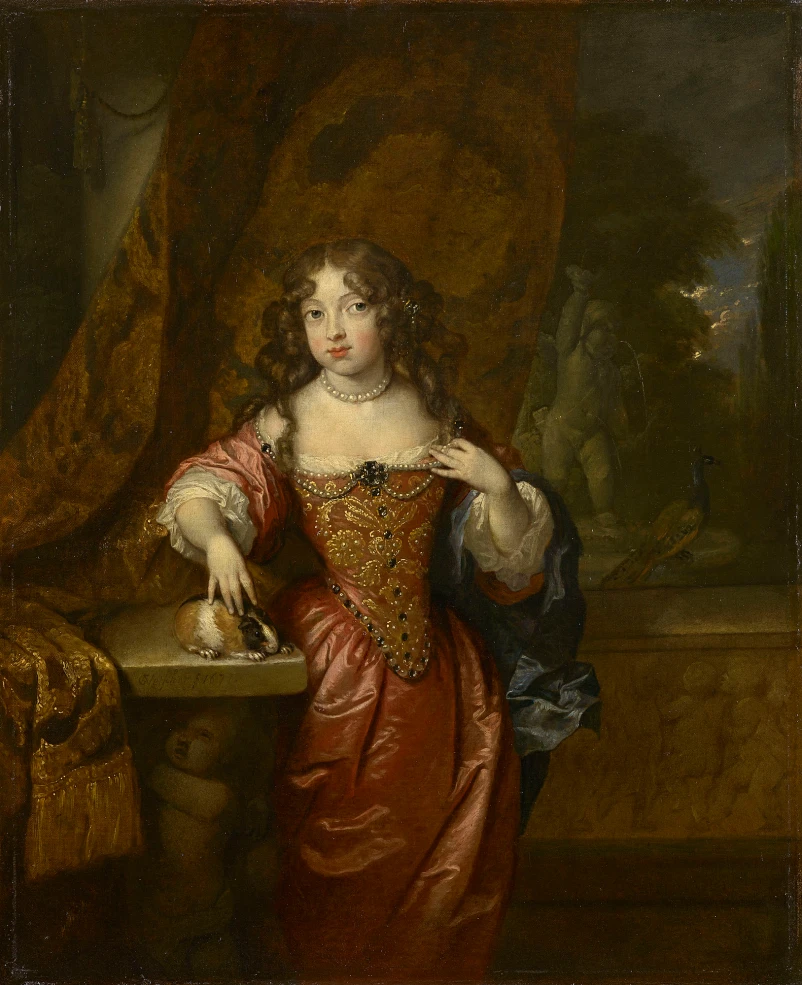
Pets in Art: Constantijn Netscher (attr.), Portrait of Sophia Charlotte, Princess of Brunswick, 1677, Kensington Palace, London, UK. Royal Collection.
Bruegel, the Guinea Pig Lover
One of the painters with affinity for guinea pigs was Jan Bruegel the Elder. He put them in several paintings, mainly depictions of the Eden Garden, most likely to show fruitfulness. They are also present in his scenes of the Holy Family, allegories, and mythological paintings. So, perhaps he just liked them? Another theory is that these animals were easy to look after and keep in the studio, therefore making them easy models. Just make sure to look closely. Guinea pigs are tiny and usually placed in the lower region of the frame.
This painting was made in cooperation with famous Flemish painter, Peter Paul Rubens.
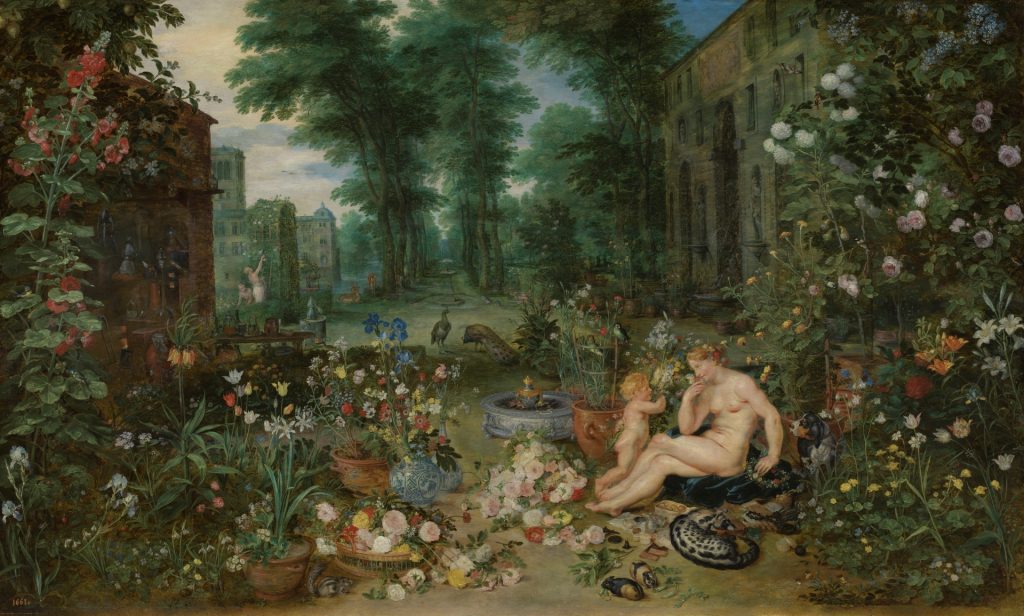
Pets in Art: Jan Bruegel the Elder, Peter Paul Rubens, Allegory of the Sense of Smell, 1617-1618, Museo del Prado, Madrid, Spain. Museum’s website.
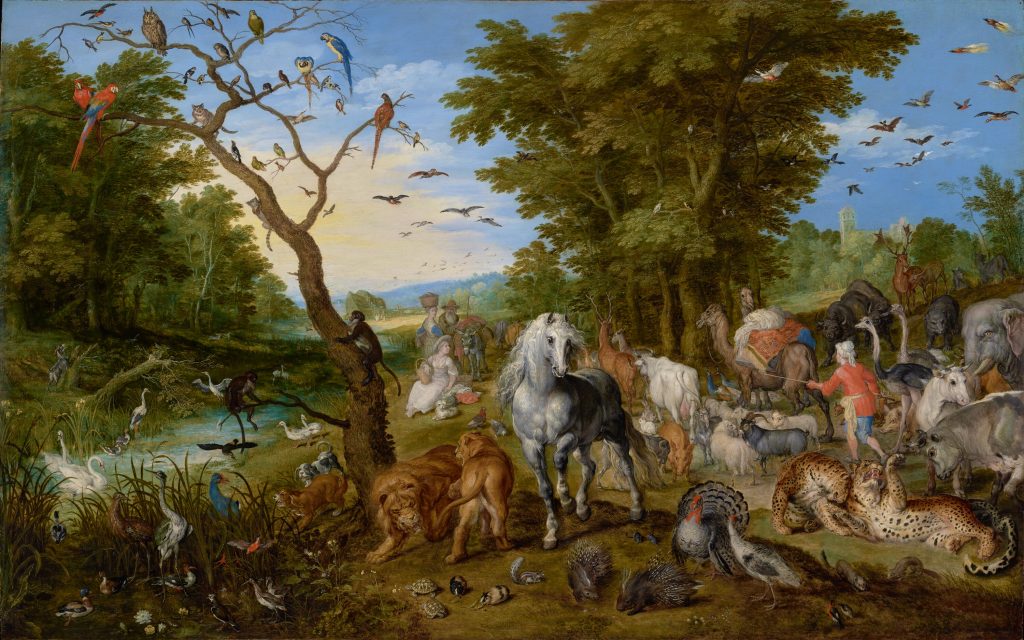
Pets in Art: Jan Bruegel the Elder, The Entry of the Animals into Noah’s Ark, 1613, Getty Museum, Los Angeles, CA, USA.
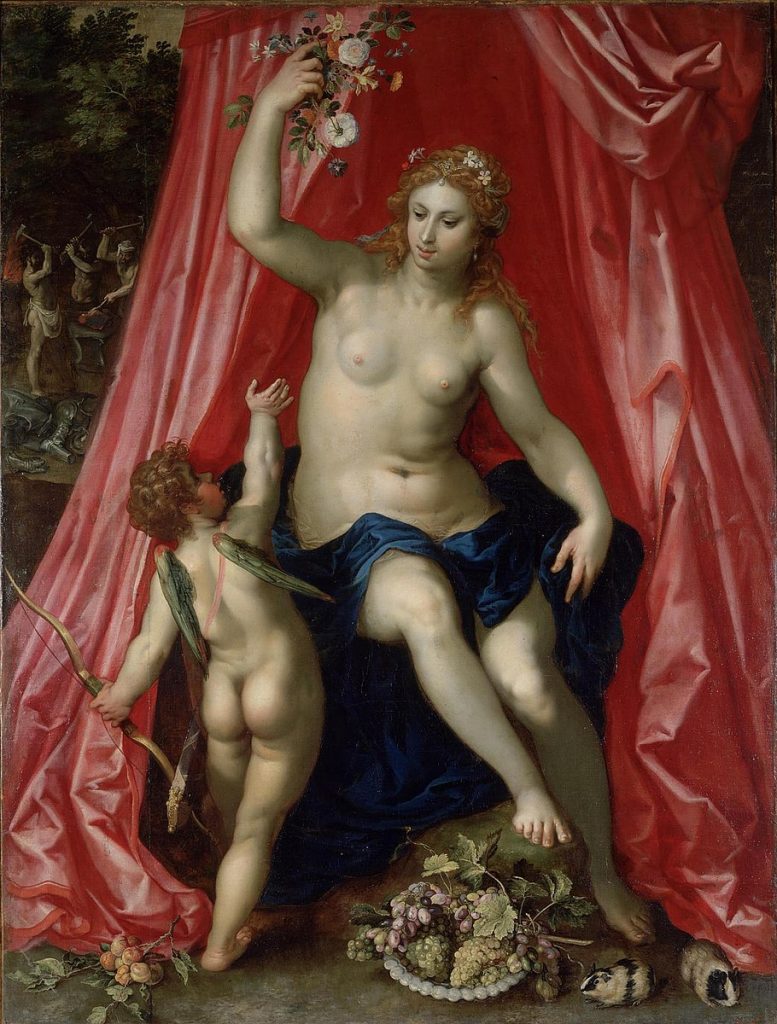
Pets in Art: Jan Bruegel the Elder, Hendrick van Balen the Elder, Venus and Cupid, 1600, State Hermitage Museum, St.Petersburg, Russia. Museum’s website.
Yummy Piggies
Please don’t eat my friends! Guinea pigs are a well-known specialty in Peru, usually served with potatoes and salsa. It hurts me just to google it, but no judgement, as every culture considers different animals as livestock. This piggie delicacy can be observed in a 1753 rendition of The Last Supper by Marcos Zapata, hanging in the historic cathedral of Cusco, Peru.
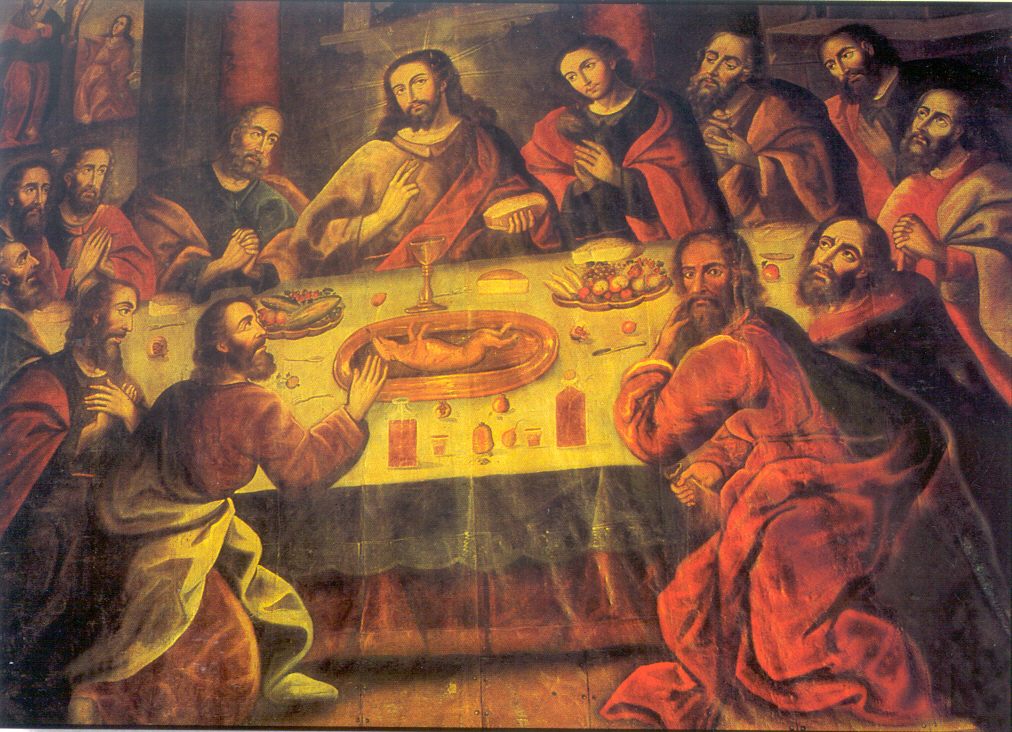
Pets in Art: Marcos Zapata, The Last Supper, 1753, Cusco Cathedral, Cusco, Peru. Atlas Obscura.
Rabbits
Rabbits are known for their incredible fertility – hence the saying “breed like rabbits” and their link with Easter celebrations. Not surprisingly, fertility, lust, rebirth/resurrection, and sex are precisely the symbols they carry in art. For this reason, they are often pictured as companions of Venus, the goddess of love.
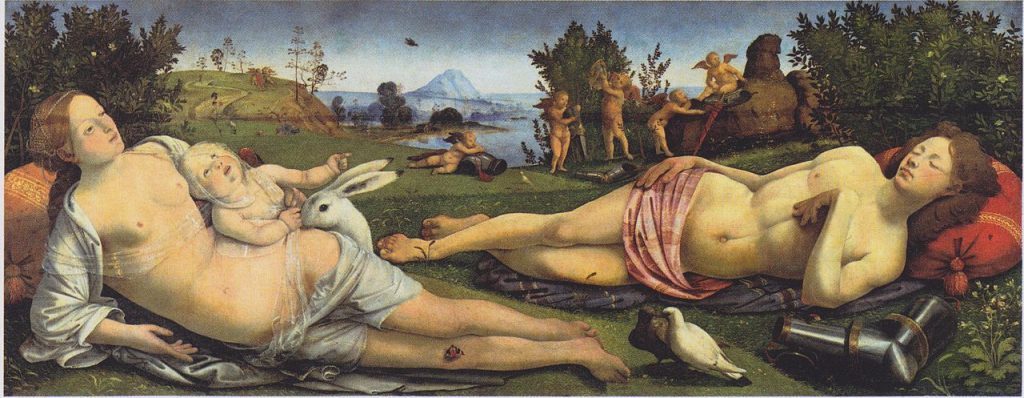
Pets in Art: Piero di Cosimo, Venus, Mars, and Cupid, ca 1505, Gemäldegalerie, Berlin, Germany.
The Rabbit Paradox
Funny enough, despite their lustful symbolism, rabbits are often used to symbolize Virgin Mary’s purity. This notion comes from the phenomenon of superfetation, especially common for hares and rabbits. Superfetation is a simultaneous occurrence of more than one stage of developing offspring in the same animal. In simpler words, this means that a rabbit can get pregnant while already being pregnant, with two completely separate instances of fertilization. Although the act of breeding still has to happen, this was often misinterpreted as virginal impregnation.
Take note – rabbits symbolizing Virgin Mary’s purity always have white coats, with the color being another symbol of chastity. Simultaneously, the rabbit as a prey animal can also be interpreted as a symbol of Christ’s sacrificial death.

Pets in Art: Titian, Madonna with a Rabbit, 1525, Louvre, Paris, France. Museum’s website.
Running Fast
Some more significant associations of rabbits in art have to do with them being prey animals. The first one comes straight from Physiologus, a didactic Christian text used as a resource for medieval artists, full of allegorical stories about animals and a future source of attributions. When describing rabbits, it states that when in danger, the animal seeks safety by running fast up towards the rock – and should it run back down, it will be quickly caught by predators. This story became an analogy for how salvation should be sought up, in the arms and rock of Christ, rather than in the earthly descent which will only lead us to the devilish predator. The hare as innocent prey can also be read as a representation of Christ himself.
Everything obviously depends on the context, especially with medieval manuscripts where they can also be gruesome rabbit killers.
Pets in Art
Here is where I finish my short look at some secrets behind pets in art. If there’s one way to sum it all up, like with anything else with art history, it all depends on context, but looking for it is always a pleasant rabbit hole to jump into. I hope this will make you look differently at your domestic companions. And let me know if you want to dive into secrets of other pets in art – perhaps your turtles or fish also deserve a small art history homage.
